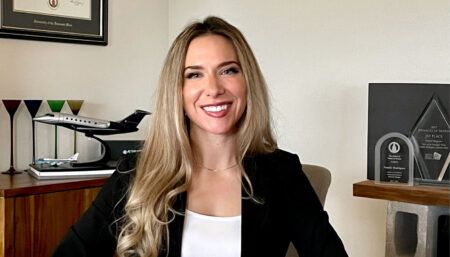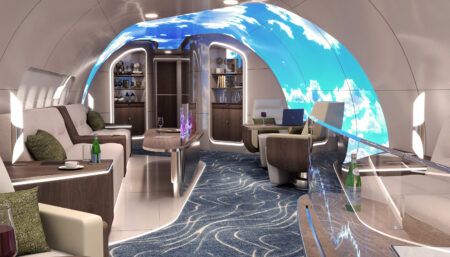Didier Wolff of Happy Design Studio sheds light on the art of painting business jets
 How did you get into designing liveries for business jets?
How did you get into designing liveries for business jets?
I have worked with images, creation and design all my life. Writing, acting, sculpture, photography and design are some of the areas of my sensitivity. Getting my flying licence brought me closer to the aviation world and naturally led me to the alliance of design and aircraft. The common theme linking all these experiences is the continuous quest of beautifying. With posters, the gallery is the open public area, the street. With aircraft livery design, the gallery is the open sky. Happy Design Studio started three years ago as a logical continuation of this rich experience and we received a fantastic response from the aeronautical industry.
 How much of your work is on business jets?
How much of your work is on business jets?
Around 50% of our work has been on private jet projects – the rest is divided between military and airline work. We expect private jet activity to grow more than the other areas from now on, due to the response from this market to our designs.
Do your designs have to reflect the interior design?
It is one scenario, if wished by the owner. Also the interior design can be inspired by the exterior livery of the aircraft. Nevertheless, there is no reason they can’t be different. In such cases, the aircraft door is the passage from one world to the other, between exterior and interior, between what is displayed and what is private.
 Have you ever had to guide a client away from a design you didn’t think would work?
Have you ever had to guide a client away from a design you didn’t think would work?
In some rare situations, requests are too far away from what the aircraft’s curves and natural aesthetic can take. I also couldn’t work on a project that I couldn’t identify with.
Do you notice differences in design preferences between regions?
We do not categorise our customers by region. To match the aircraft’s exterior design with personal taste, you first need to know that it is possible to depart from the usual classic scheme. Personal will and audacity are important traits of our clients.
 What is the most challenging aspect of your job?
What is the most challenging aspect of your job?
Supervising the painting process. In the paint shop I have a limited time frame to ensure that the design will adapt perfectly onto the aircraft with absolutely no mistakes. This part of the job brings together a devoted team with absolute precision. As with a musical instrument, the livery must be tuned up perfectly and thrill from every angle. During the creation phase I dedicate my attention to all the angles the aircraft can be seen from – from underneath of course, but also from a terminal room and from air-to-air shooting angles, so for instance it can be used to promote the company’s new identity. Definitely, the supervision part is by far the most thrilling phase as everyone creates a unique and extremely sensitive relationship with the aircraft – mostly because no one can fail. When the aircraft is delivered to the owner, we have to be proud of the work that has been done.
How often do business jets have to be painted?
Each aircraft type has its own cycle of technical checks so there is no general answer for this question. On top of that, in most cases an aircraft will require a paint job when it is sold.
 What paint do you use?
What paint do you use?
Unless this question is left to us to decide, we often go with the workshop’s usual paint supplier. In all cases, we make sure the paint is made according to the requirements for quality issues. We mostly use a base coat followed by a clear coat, a rather new technique that allows complex coloured designs to be implemented with as little as possible impact on the aircraft’s downtime.
How long does the painting process take?
It depends on various issues – the aircraft size, the condition of its existing paint, the complexity of the design – but roughly between five and 15 days.
Do you regularly work with the same paint facilities?
Of course I have my preferences, mostly because of relationships built through what is always a fabulous team experience – painting a challenging design. These experiences have created very strong relationships and a full knowledge of each paint completion centre’s abilities. Nevertheless, sometimes we have to comply with the customer’s constraints and work with new workshops. Most of the time this is for the best, as it increases our network throughout the world.
 How do you ensure the design is adhered to accurately?
How do you ensure the design is adhered to accurately?
That is one of our major selling points. We supervise the aircraft painting every time. It is mandatory because without this close and intense supervision, no matter how great the paint shop is, third parties’ interpretations of lines, curves, intensity, proportions etc will affect the overall balance of the design. Even with the back-up of an engineering order (a technical map of the design on the aircraft scheme) adjustments on the real aircraft are always necessary. I personally supervise each step of the painting process, from colour checking to final inspection.
What has been your most memorable project so far?
I think of it each and every day – when the French Air Force let me work on two Rafales, to be painted in five days within the French Army base at 113 St Dizier. All conditions – human and technical – united to create the perfect job. The trust they put into my work – giving me the opportunity to work on aircraft worth US$170 million each by just telling me “It’s yours now” – gave me wings. There was also a feeling of brotherhood, to be accepted as a civilian to work within such a small and unique community.
What future projects would you most like to work on?
Definitely another military aircraft.
Didier Wolff is owner/designer at Happy Design Studio





